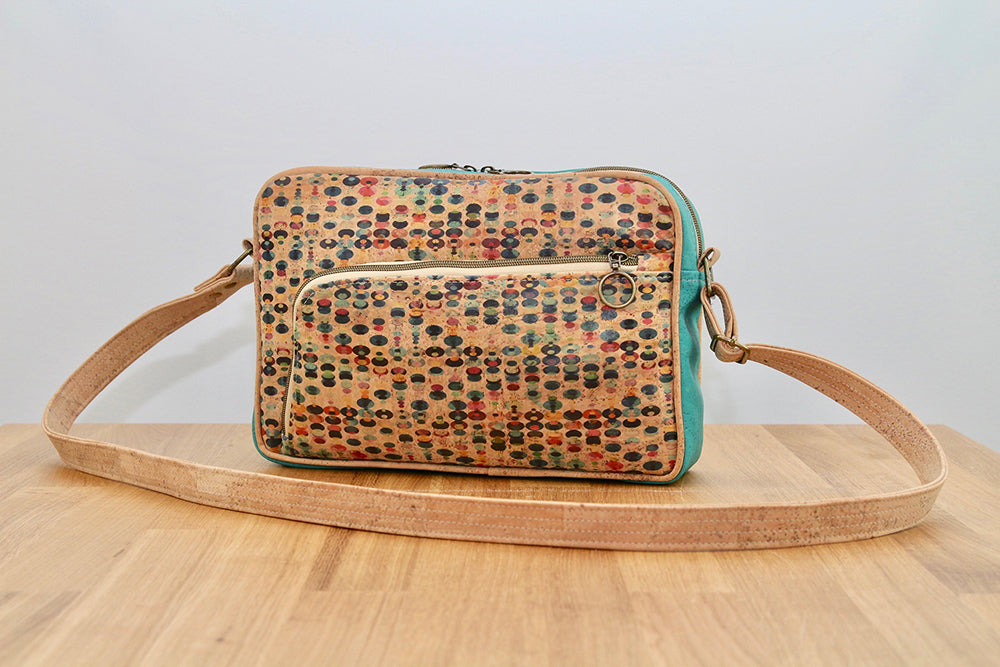
Cork it Up : Celosia Cross Body Bag - with front pocket card slot addition
Share

The “Cork it Up" series, is a collection of tutorials that show you how to adapt some of my existing patterns to an all cork exterior.
In this blog tutorial I feature the Celosia cross body bag. Celosia is a medium-sized cross body bag with a front exterior zippered pocket and an additional 3 pockets inside the bag. I have also added card slots to the front exterior zippered pocket in this tutorial, however, it is optional.

A word of caution - this bag has thick layers in some areas, especially where the zipper tabs are located for the exterior pocket. I would not recommend the cork piping unless you are confident your machine can handle thick layers.
As usual, all cork used for this project was purchased from MM Cork Supply and owner Sheri Ferraro provided her expertise.
Let's get started!
NOTE: If you prefer following along with a video, see the end of this blog post for a link to the first video in the tutorial series. Please note that the video tutorial is for fabric, not for cork. You must read and complete the modifications to the bag included in this tutorial before completing the steps in the videos.
SUPPLY LIST CHANGES:
How much cork do I need?
If you are purchasing from MM Cork Supply, you will want to purchase a half yard of cork (18" H x 54" W). ***Please note that other vendors will call a much smaller piece a “half yard” of cork and that will not be enough. You need a piece that is 18" H x 54" W.
For your adjustable strap, you can either follow the cutting instructions to make your own in cork OR you can buy MM Cork Supply's pre-made 1" strapping. I will be making my own for this tutorial following my instructions in this video. If you want to use the strapping, you will need to purchase 1.5 yards to make a 54" adjustable strap.
Other changes:
- Omit foam interfacing
- You will substitute the foam interfacing with some additional fusible fleece. You will need approx. 1/3 yd of fusible fleece that is 45" wide. (I use Pellon Thermolam Plus fusible fleece)
- Since I am not using any foam interfacing, I will add a small piece of firm interfacing (I use Pellon Peltex) to the bottom of the bag. Additionally you’ll need a gusset firm interfacing piece that is 10" W x 2.75" H. You will also need a small piece for the Card Slot of firm interfacing that is 7.5" W x 4" H.
CUTTING CHART CHANGES:
I have created a revised cutting chart for your convenience. Please download it and use it to cut your pieces.
INTERFACING CHANGES:
Skip steps 1 to 4 from the pattern. Instead, follow these steps:

1. Take your GUSSET exterior cork piece and fold in half vertically and mark the centres along the top and bottom edges on the WS.
2. Mark the centres on your GUSSET FIRM INTERFACING Peltex piece. These marks will be at the 5" mark along the longer edge.

3. Use fabric glue to attach the GUSSET FIRM INTERFACING Peltex piece to the WS of your GUSSET cork piece. Allow the glue to dry.

4. Because we are fusing fleece to the WS of the lining pieces, we will need to cut out a rectangle opening for the zipper pocket from ONE of the MAIN BODY fusible fleece pieces. This will prevent too much bulk at the zipper pocket's opening. To do this, start by folding your fusible fleece piece in half, vertically, and marking the centre along the top and bottom edges. These centre marks will allow us to cut out a rectangle opening that is perfectly centered on the fleece.

5. Draw a rectangle on the fleece that is 2" down from the top edge, 9" wide and 3/8" high.

6. Cut out the rectangle shape from your fleece and then fuse to the WS of one MAIN BODY lining piece. You will use this lining piece when installing your zipper pocket, making sure the rectangle you draw on your ZIPPER FACING piece is placed directly over the cut out rectangle in the fleece.

7. Take both ZIPPER PANEL fusible fleece pieces and trim away 3/8" from one longer edge. Fuse to the WS of your ZIPPER PANEL lining pieces leaving the 3/8" gap along the edge that will be sewn to your zipper.
EXTERIOR ASSEMBLY
Step 5: Since you are using cork, you will not be pressing with an iron. Instead, draw a line on the WS of the RECTANGLE RING CONNECTOR. You will then fold in each half towards the centre line and sew in place as you are folding with 1/8" seam allowance from the centre line. You can then topstitch both longer sides again with 1/8" seam allowance from the edges. Complete step 6.
Step 7: This step is the same however make sure to use the ZIPPER TAB lining pieces so they are on the WS of the zipper.
Before continuing with step 8, we will create our card slot piece.
CARD SLOT ASSEMBLY

1. On the WS of your card slot fabric, draw lines according to the measurements in the photo above: 2.5" from the left side, then 1.75", 2.25", 1.75", 2.25", 1.75" and then finally 2.25". The section that is remaining on the right will be folded behind the card slots.
2. Start by folding the first line at 2.5" so the fabric is WST and press. Then fold the 1.75" line RST and press. Then fold the 2.25" line WST and press. Continue folding - the 1.75" lines are always RST and the 2.25" lines are always WST, making sure to press each fold carefully.


3. When you are done pressing, the first photo above shows the card slots from the front view and the second photo above shows the card slots from the back view.

4. Topstitch the folded top edge of each card slot, moving the others out of the way.

5. Pin your card slots so there's an equal amount of space between them and then baste stitch them in place along both sides with 1/4" seam allowance to hold them in place.

6. Open the card slot piece at the bottom and insert the CARD SLOT FIRM INTERFACING in between the layers, making sure you've inserted it as far as it will go to the top. Baste the bottom shut with 1/4" seam allowance.

7. Make a mark at the centre of the card slots - about 4.25" for either side - along the top and bottom edges.

8. Sew from the bottom mark up to the top centre mark, making sure to backstitch at each folded edge, including the last one at the very top. You should now have 6 card slots.

9. Take one CARD SLOT BINDING piece and fold in half lengthwise, WST, and press.

10. Open up the binding piece to reveal the centre crease, then fold in each half towards the centre crease, WST, and press.

11. Fold the binding piece in half again, RST, so the raw edges at the middle are showing on the exterior.

12. Sew one end of the binding piece with 3/8" seam allowance, making sure to backstitch at the beginning and the end. Trim seam allowance to 1/8".

13. Flip the binding piece so it is RS out. You will need to gently push out the corner with a chopstick or similar object. Your raw edges should now be hidden inside. Press.

14. Insert one side of the card slot piece in between the layers of the binding piece and use clips to hold in place. Sew in place with 1/8" seam allowance along the side closest to the card slots. Make sure to backstitch at the top edge.
Repeat steps 9 - 14 for second binding piece and attach to the other side of the card slots.

15. Pin your assembled card slot piece on one FRONT POCKET lining piece, centered. Note that the lining piece must have the curve exactly as shown in the photo above. Sew along both sides with 1/8" seam allowance from the outer edge of the binding. Make sure to backstitch at the top edge.
PIPING CHANGES
If you've decided to add the optional piping, but you are using cork piping instead, you'll want to follow these steps to finish off the piping on a MAIN BODY panel:

1. At the bottom edge of the MAIN BODY panel where you started basting your piping, you'll want to overlap the piping by 1-2" and then cut the excess.

2. If you have cording sticking out the end of the piping, trim it to the edge of the piping.

3. Remove the basting stitches from the end of your piping to reveal the cording inside.

4. Insert the beginning of the piping into the end of the piping where you've just removed the basting stitches. You are tucking in one end of the piping in between the layers of the opposite end. Trim the cording so that the ends meet perfectly.

5. Apply fray check to the shorter ends of your piping to prevent fraying.

6. Finish basting the piping to the MAIN BODY piece.
Complete the bag's assembly according to the pattern/video series instructions.
FREE VIDEO TUTORIAL:
